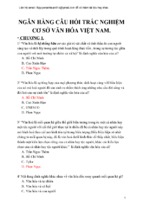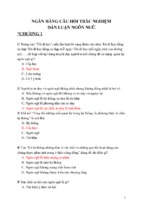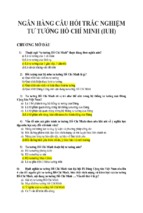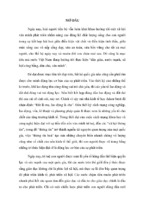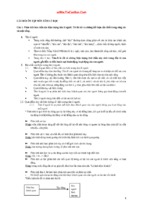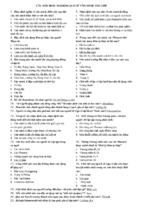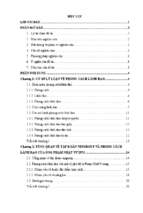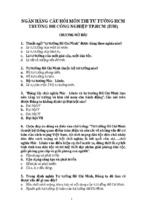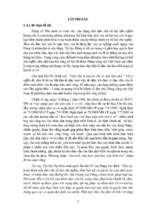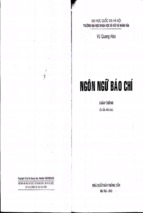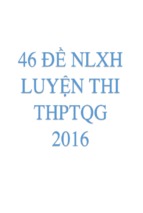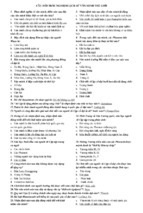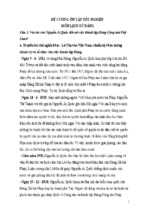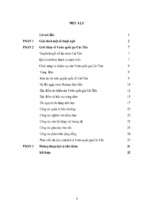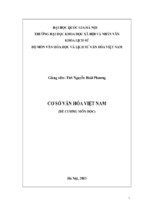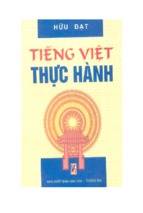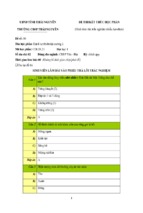MINISTRY
OF EDUCATION
‘
MINISTRY OF AGRICULTURE
AND TRAINING
AND RURAL DEVELOPMENT
VIETNAMESE ACADEMY OF FOREST SCIENCES
==================
PHAM QUOC CHIEN
ĐOÀN NGMAIỌC DAO
STUDY ON SCIENTIFIC BASES TO CHANGE THE SMALL
TIMBER PLANTATION INTO LARGE TIMBER
PLANTATION OF ACACIA MANGIUM WILLD IN
BAC GIANG PROVINCE
Specialty: Silviculture
Code: 9620205
SUMMARY OF DOCTORAL THESIS
Hanoi - 2020
1
The thesis is completed at Vietnamese Academy of Forest Sciences
Supervisor:
1. Dr. Dang Thinh Trieu
2. Dr. Dang Van Thuyet
Chairman:
Reviewer 1:
Reviewer 2:
Reviewer 3:
The thesis was approved by Dissertation Committee at
academy level in Vietnamese Academy of Forest
Science
On date , 2020
Thesis may be referred to in the National Library
of Vietnam and Library 2of Vietnamese Academy of
3
INTRODUCTION
1. Background
According to the Vietnam Administration of Forestry (VNFOREST)
(2019), by 2018, the area of Acacia plantations reached 1,515,898
hectares, accounting for 53.6% of the total plantation nationwide. The area
of monoculture stands of Acacia mangium accounted for about 50% of the
total and the majority of this plantations have been planted in high density
to provide small timber for pulpwood or woodchips. The Ministry of
Agriculture and Rural Development (MARD) has set a goal of establishing
201,220 ha of large timber plantations, of which 28,658 ha of small timber
plantations are going to be changed into large timber area.
At present, the thinning activity for large timber plantations is of
interest. A number of researches on thinning have also been conducted,
however researches on the changing of A. mangium forests are still
limited.
Acacia mangium Willd is one of the three large timber species of the
Acacia genera which are widely grown in Vietnam but often grown in high
density and short rotation for pulpwood or woodchips. These forests are
quite suitable for thinning to convert into large timber production.
However, further researches are needed on the scientific basis as well as
the economic effects of the conversion prior to any wide adoption.
Given the aforementioned practical need, the topic "Study on
scientific bases to change the small timber plantation into large timber
plantations of Acacia mangium Willd in Bac Giang province" was
conducted.
2. Meaning scientific and practical
- Scientific significance
1
Provide further scientific bases for the changing of small timber
Acacia plantation into large timber plantation.
- Practical significance
Identify productivity, quality and economic efficiency of Acacia
mangium plantation in Yen The, Bac Giang after thinning.
3. Objectives
+ General objective
Identify the scientific bases for the changing of small timber
plantations of Acacia mangium into large timber plantations in Yen The,
Bac Giang.
Determine the best density after thinning to ensure higher
productivity, quality and economic efficiency than plantations un-thinning
of Acacia mangium forests in Yen The, Bac Giang.
+ Specific objectives
Specific objectives of the research include (i) assesssing the current
status of changing of small timber plantation into large timber plantations
in Bac Giang; identifying the effects of thinning on the growth of Acacia
mangium plantation; identifying on the effects of thinning on the quality
of Acacia mangium timber and identifying the economic efficiency of
Acacia mangium plantation after thinning.
4. New contribution of the thesis
- Determined the effects of thinning on the growth parameters,
productivity and quality of Acacia mangium plantation in Yen The, Bac
Giang.
- Identified the economic efficiency of large timber plantations of
Acacia mangium after thinning in Bac Giang.
6. Research scope
2
- The research contents:
(1) Assessment of the current situation of changing of small timber
plantation into large timber plantations in Bac Giang. As for this content,
the thesis only focuses on assessing the area of Acacia mangium
plantations, the changing of small into large timber plantations (time,
scope, location, tree growth); advantages and disadvantages in the
conversion of planted forests.
(2) Research on effects of thinning on the growth of Acacia
mangium plantations (including diameter at breast height, basal area;
crown diameter, height, volume; leaf area index; canopy cover and
photosynthesis).
(3) Research on effects of thinning on the quality of Acacia
mangium timber (including number of knots; rate of heartwood and
sapwood; utilization rate of saw timber).
(4) Assess the economic efficiency of Acacia mangium plantations
after thinning in two scenariors including sale the timber at the harvest
site and sale the lumber.
- The specific of research location:
+ Activities of the contents (1) were conducted in Son Dong, Luc
Ngan, Luc Nam and Yen The districts, Bac Giang province.
+ Activities of the contents (2), (3) and (4) were carried out in Yen
The district
- The research period: The research was carried out in 5 years from
2013 to 2018.
7. Thesis layout
3
The thesis summary has25 pages, including 11 tables, 01 figures, and is
structured into the following contents: Introduction: 3 pages; Chapter 1:
Literature review: 3 pages ; Chapter 2: Contents and Methods: 5 pages ;
Chapter 3: Results and discussions: 11 pages ; Conclusions and
recommendations: 3 pages.
Chapter 1. LITERATURE REVIEW
1.1. Situation
of research in other countries
Acacia mangium Willd. is native to Australia, Papua New Guinea and
Indonesia. It is fast growing and adaptable on a variety of site conditions.
Acacia mangium therefore plays an important role in reforestation
programs. Different studies on this species have been conducted in many
countries, from biological characteristics, variety selection to planting
techniques as well as usability.
Thinning is usually carried out in a plantation after its canopy is closed
with the aim of adjusting the density so that the stand always approaches
the optimal density to promote the growth of diameter and height so that
the highest productivity can be obtained from the stand (Rollinson, 1988b).
Nicholas (1988) relied on canopy diameter criteria as a basis to determine
the final density after thinning, taking advantage of the growth in diameter
of crops in a 40 years production rotation in New Zealand.
Thinning affects the growth of trees, thereby affecting the leaf area
index (LAI). LAI of the Acacia tortilis was influenced by nutrition and
time of year (Elfeel and Abohassan 2016). In places where planting is
thick, the trees grow well; the leaf area index can be up to 400-500%. With
low leaf area index, trees do not make full use of light and space so
economic productivity is not high. In cased that the leaf area index is too
high, the leaves cover each other's light and dispute the living space so
4
there is no high economic productivity. LAI can be used as a characteristic
quantity to describe the canopy of an ecosystem. Through this index we
can predict primary production of photosynthesis, and evapotranspiration.
It is also a reference tool for plant growth.
After thinning, the light regimes of the remaining trees were the most
obvious and significant changes (Wang et al. 1995, Tang et al. 1999). The
photosynthesis capacity of leaves is enhanced due to the increased light in
the canopy (Ginn et al. 1991, Tang et al. 1999). The photosynthesis
effectiveness increase sharply, immediately after thinning, then gradually
decreases when the canopy is closed (Gravatt et al. 1997). The increased
photosynthetic capacity (Amax) observed after thinning is mainly the
change in photosynthesis capacity among mature leaves in the lower and
middle canopy layer. These increases, combined with improvements in the
micro light environment, may be a key in strengthening plant growth after
thinning.
The economic efficiency of thinning depends on the combination of the
yield level, price, and the ability to stabilize the productivity of the
plantation. The thinning activity contributes to the sale increase but at the
same time the plantation will bear the risks in places with unstable external
conditions.
1.2. Study in Vietnam
Beadle et al. (2013) studied the effects of thinning on 2.5 years old
Acacia hybrid plantation in Dong Hoi (Quang Binh), after 2 years of
experiment, it is showed that thinning has markedly affected growth of
these plantations (diameter; height; timber volume).
Tran Lam Dong (2018), after 3 years of thinning in Yen Bai and 2
years in Nghe An, most thinning formulas yielded lower or equal reserves
than the un-thinning treatments, so there was no value in case of selling
5
small timber price. However, in the current production, the price of wood
increases with diamter size and depends on the degree of the suitability
required as raw materials for woodchip, peeled or sawn timber. The
thinning formulas all showed higher values than the control treatments,
except for the conversion forest at age 3 in Nghe An, the difference was
not significant. In Yen Bai, the total value reached the highest when
thinning was applied, leaving a density of 1,000 trees ha -1, reaching VND
193.6 million (fertilizer application ) and VND 184.8 million VND
(without fertilizer application), compared with un-thinning (VND 147.1
million dong and VND 165.2 million, respectively), in which, the value of
wood with D1.3> 15cm is VND130.5 million (without fertilizer
application) and VND 118.6 million (fertilizer application), compared with
without thinning (VND 67.5 million and VND78.8 million, respectively).
Thus, previous studies indicated that the growth of tree in thinning
tratments was much better than those from the trees in un-thinning
treatment.
1.3. Comment
From the overview of domestic and foreign researches, it shows that A.
mangium plays a relatively important role in afforestation in Vietnam as well
as in many other countries. Regarding researches on thinning techniques for
nurturing planted forests, , the researches in the world on planting large
timber forests of Acacia and Eucalyptus species have been carried out quite
comprehensively, especially on silviculture techniques of thinning in
plantation forests. These studies have created a scientific basis for intensive
afforestation, conversion of small timber production forests to the supply of
large timber of acacia and eucalyptus species; contributing to providing raw
materials for processing in countries around the world in recent years.
In Vietnam, domestic researches mainly focus on species of Acacia,
6
Eucalyptus, Bodhi, and Cunninghamia (Sa Mộc) with the main purpose of
providing small timber. Recently, there have been many studies on
planting large timber forests, thinning techniques to transform small into
large timber production plantations of some species such as Acacia and
Eucalyptus. However, these studies still have some shortcomings, such as
researches on the conversion of small into large timber production forest
conversion were carried out on a narrow scale; monitoring and evaluation
time is not long; there have been very few studies on the effects of
thinning on leaf area index, photosynthesis intensity as well as sawn
timber quality. Especially in Bac Giang in particular and in the Northern
Uplands in general, there are no in-depth studies on thinning effects on
some of the above indicators.
Given the above-mentioned practices, the implementation of "SStudy
on scientific bases to change the small timber plantation into large
timber plantations of Acacia mangium Willd in Bac Giang province" is
necessary and meaningful in terms of scientific and practical aspects.
Chapter 2. CONTENTS, MATERIALS AND METHODS
2.1. Contents
In order to achieve the thesis’ objectives, following activities have been
carried out:
- To assess the current situation of the changing of small timber plantation
into large timber plantation in Bac Giang province
- To study the effects of thinning on the growth of Acacia mangium, which
include effects of thinning on the survival rate; LAI and photosynthesis;
diameter and basal area; tree height; crown diameter; diameter distribution
and timber volume.
7
- To study the effects of thinning on the quality of timber of Acacia
mangium plantation, which include effects of thinning to quantity and size
of knot; to saw log utilization rate and volume of chipwood.
- To assess the economic efficiency of Acacia mangium after thinning,
including economic efficiency when selling timber at harvesting site; and
the economic efficiency when selling lumber products.
2.3. Methods
2.3.1. Methods to assess the situation of changing of small timber
plantation into large timber plantations in Bac Giang
The interview method combined with survey were applied in this
study. Total of interviewer were 12 households who changed their small
timber plantations into large timber plantations. On the plantation area of
each households, three plot with an area of 500 m2 were established to
measure the DBH (D1.3), total height and crown diameter. The total
number of the plots was 36. The survey was conducted from November to
December, 2018.
2.3.2. Experiment
and data collection
2.3.2.1. Experiment
Different thinning regimes were establsihed for 3 (planted in 2010), 4
(planted in 2009) and 5 (planted in 2008) years old plantatations such as:
- Three years old plantation: CT1 (un-thinning); CT2 (thinning to 1100
trees ha-1); CT3 (thinning to 800 trees ha-1) and CT4 (thinning to 600 trees
ha-1).
- Four years old plantations: CT5 (un-thinning); CT6 (thinning to 800
trees ha-1) and CT7 (thinning to 600 trees ha-1).
8
- Five years old plantations: CT8 (un-thinning); CT9 (thinning to 800
trees ha-1) and CT10 (thinning to 600 trees ha-1).
The treatments were layouted as rondomized complete design with
three replications of 0.12 ha giving total of 3.6 ha. Experiments were
conducted from 2013-2018.
2.3.2.2. Data collection
- Growth parameters: In each replication, a plot with 500 m 2 were
establish to measure the survival, D1.3; total height and crown
diameterand.
- Leaf area index and canopy: In each replication, five hemisphere
photos were taken using digital camera (Nikon Coolpix 8400) with fisheye
lens (Fisheye FC-E92 180o). The leaf area index data was collected once
in April 2019. The total number of photos taken was 50, of which the
experiment carrying out thinning at 3-year plantation took 20 photos. As
for experiments with 4 and 5-year plantations, taking 15 photos for each.
The photosynthesis data was also collected in April 2019. The Licor6800 was used to measure photosynthesis of leaves in the chamber with
light intensity of 1,500 μmolm-2s-1 (A 1,500 μmolm-2s-1), the
concentration CO2 is 400 μmol liters of air -1, air humidity 70% and air
temperature 25oC. At each iteration, select a tree of medium diameter to
get branches for experiments. In each tree, choose 2 branches with a
diameter of 1.5 - 2.0 cm. A branch at position of ¼ (upper layer-Tr) and a
branch at position ½ (lower layer-D) of the canopy from top to bottom are
selected to measure photosynthesis. The branch chosen to measure was the
leafy branches that receive full sunlight. Medium-old leaves were used for
this measuring. The measurement was carried out 4 times per day at 5:00;
9:00; 13:00 and 17:00.
9
2.3.2.3. Methods to assess the timber quality
In each replication, we selected 3 trees that are close to the average
size for cutting. The total number of cutting trees was 90, of which, 36
trees belonged to 3 years old ; 27 trees were used for each thinning
experiments in each 4 and 5 year plantations.
After cutting, the stem length to the 10.0 cm-diameter positionwas
measured. Cut each stem into 60 cm in long until it reaches the 13.0 cmdiameter position. The stem part having diameter of from 10.0 cm to less
than 13.0 cm is cut into pieces with a length of 120 cm. Measure the
diameter in the middle of logs for all logs, then remove bark and measure
the diameter in the middle of logs. Count and classify pieces of cut logs by
each diameter class which is 2.0 cm apart. The quality criteria of log
collected include heartwood, sapwood, number and size of the knots.
2.3.2.4. Data analysis
+ Method of data analysis for leaf area index and photosynthesis
The photos after capture were analyzed by gap light analyzer (GLA)
according to Frazer et al. (1999) to assess canopy cover and leaf area
index. The leaf area index (LAI) is calculated according to Stenberg et al.
(1994), applying a zenith angle from 0 - 60 °.
The photosynthesis of leaves from Licor-6800 was transferred to
Microsoft Excel software version 16.29.1 for synthesis and analysis.
+ Method to asses sawn timber utilization and volume of chipwood
Upon the classification, the lumpers were produced with a
dimensions as in Table 2.1 (the standard based on ordered by Woodsland
Joint Stock Company, Quang Minh Industrial Park, Hanoi with Yen The
Two-member Forestry Limited Company).
10
Table 2.1: Dimensions of lumper and it’s prices
Dimension (cm)
Thickness
Width
Length
Product
notation
2.1
5.4
120.0
A
3,400,000
2.1
10.0
60.0
B
4,800,000
2.1
5.4
60.0
C
4,100,000
1.5
5.1
60.0
D
3,800,000
1.5
6.5
60.0
E
3,200,000
Price (VND/m3)
The utilization rate of sawn timber is calculated by the total of lumper
volume / total of timber volume of the sample tree. The total volume of
lumper per 1 ha is calculated by multiplying the percentage of sawn timber
utilization of sample trees with standing tree volume per ha.
+ Method to assess the ratio of heartwood, sapwood
After bark removal, measure the diameter of heartwood of three logs
representing three positions of a tree such as base (the first segment at the
base); middle part (the segment in the middle of the body) and the top (the
last segment in the top). Calculate volume of core wood and sapwood for
each piece and for the whole tree.
+Method to assess quantity and size of the knots
After bark removal, count and measure all knots (where branches
form, protrusions are not knots) on logs and divide into two types: live
knots and dead knots, measure the size of each type of knot in two
dimensions perpendicular to each other to get the average value. The
number of knots is calculated for each of the 120 cm segment (1 or 2
pieces as above mentioned) until a length of 9.6m from the root to the top,
then the total number of knots of the whole tree.
11
2.3.3. Assess economic efficiency of Acacia mangium plantation after
thinning
The economic efficiency was calculated in 2 options of selling
timber at harvesting site and selling lumper products, specifically as
follows:
- The economic efficiency of selling timber at harvesting site
Data on costs and income of the treatments was collected; thereby
the economic efficiency of thinning treatments was assessed and compared
with the same of un-thinning plantations. The criteria include:
+ Net Present Value (NPV)
+ Benefit to Cost Ratio (BCR)
+ Internal Rate of Return (Internal Rate of Return)
- The economic efficiency of selling lumper products
Lumper products were made from logs with a small diameter of ≥
10cm. The economic efficiency of selling lumper products also included
NPV; IRR and BCR. Costs applied to the economic efficiency of selling
lumper products also includeed the above-mentioned expenses and other
costs in the processing process, including: the cost of transporting timber
from harvesting site to processing facility and the cost of wood processing,
the cost of transporting lumper products to the place of order. The costs
and income are applied at Yen The Two Member Forestry Company, Ltd.
12
Chapter 3. RESULTS AND DISCUSSION
3.1. Situation of changing the small timber plantation into large timber
plantation in Bac Giang
According to the Restructuring Agriculture Sector Plan of Bac Giang
Province in the period of 2015 - 2020, by 2020, enrichment of natural
forests of about 1,000 ha will have been implemented; 2,300 ha poor
natural forests to plant production forests rehabilitated; 29,000 ha of
concentrated forests planted. The average productivity of plantation will
increase to 20 m3/ha/year. 7200 ha of large timber plantation will have
been established, accounting for 10% of production plantation area. This is
the basis for implementing the conversion of planted forests in general and
Acacia mangium in particular in order to quickly improve the productivity
of planted forests in the province.
At present, the area which is feasible to produce large timber in Bac
Giang province as follows: plantation forest: 17,998 ha including 4,609 ha
of Acacia hybrid plantations and 13,390 ha of Pine and Acacia
plantatations.
- Natural regeneration and additional planting of large timber tree:
1,836 ha.
It is expected that by 2020 the whole Bac Giang province will
continue to their target of planting 15,000 ha of large timber plantation in
four key districts named Son Dong, Luc Ngan, Luc Nam and Yen The.
A intensive planting model of large timber tree species with Acacia
mangium was carried out in three years (2014, 2015, 2016). The total area of
the model in Bac Giang is 120ha (Bac Giang Forest Protection Department,
Review report on forestry extension models)
Table 3.3: Area of large timber plantation in Bac Giang
13
Year
Area (ha)
Location
No. Of participating
households
2014
20
Luc Ngan, Son Dong
22
2015
50
Luc Nam, Luc Ngan, Son
Dong, Yen The
28
2016
50
Son Đong, Luc Ngan
20
Total
120
3.2. Effects of thinning to the growth of Acacia mangium
3.2.1. Survival rate
70
Five years after experiment, the mortality rates among the treatments
were different between treatments. In general, the treatment of un-thinning
had a higher mortality rate than that in the thinning treatment (Table 3.5).
In the treatment of thinning to 600 trees /ha, the mortality were 0.4%,
2.0% and 0.9% for 3, 4 and 5 years old plantation experiments,
respectively.
14
Table 3. 5:Survival rate of Acacia mangium after 5 years of the experiment
Survival rate of Acacia mangium (%)
Treat
ment
CT1
CT2
CT3
CT4
CT5
CT6
CT7
CT8
CT9
CT10
After
Nov./
thinni
2014
ng
Nov./
2015
Nov./
2016
Nov./
2017
Nov./
2018
100
100
100
100
100
100
100
100
100
100
93.2
98.2
98.3
100.0
93.8
97.5
97.8
95.0
98.3
98.9
87.3
95.8
95.8
100.0
90.1
95.0
96.7
90.6
97.5
97.8
81.7
92.1
94.2
97.8
87.0
92.5
95.6
86.2
94.2
96.7
74.5
85.5
91.7
97.8
84.6
90.0
94.4
83.1
92.5
95.6
96.6
100.0
100.0
100.0
97.5
100.0
100.0
97.5
100.0
100.0
15
Average mortality
(%/year)
During Prior to
Final
the
the
density experime experim
-nt
-ent
1.170
5.1
2.0
940
2.9
2.0
733
1.7
2.0
587
0.4
2.0
914
3.1
4.75
720
2.0
4.75
567
1.1
4.75
886
3.4
4.0
740
1.5
4.0
573
0.9
4.0
3.2.2. Leaf area and photosynthesis indices
3.2.2.1. Leaf area and canopy cover index
Leaf area index (LAI) and canopy cover of Acacia mangium plantation
5 years after the thinning is presented in Figure 3.1.
- Leaf area index (LAI): Thinning has a remarkable effect on leaf
area index. The thinning to 600 trees/ha has the lowest leaf area index,
respective followed by un-thinning and the thinning to 800 trees / ha,
respectively.
- Canopy cover index: The thinning to 800 trees/ha has the highest
canopy cover index, followed by the treatment of un-thinning and thinning
to 600 trees/ ha.
2.5
79
1.5
76
1
73
Độ tàn che (%)
LAI (m2m-2)
2
0.5
0
70
LAI
Độ tàn che
Figure 3. 1: Leaf area and canopy cover index of Acacia mangium
3.2.2.2. Photosynthesis
Table 3. 1: Photosynthesis of Acacia mangium in different times in a day
Treat
ment
CT1
CT2
Positi
on of
leaf
cut
Tr
D
Tr
A (μmol m-2 second-1)
Á
Á
(μmol
m-2 s-1)
5:00
9:00
13:00 17:00
(μmol
m-2 s-1)
1.82
2.31
2.24
7.24
8.44
6.28
6.45
7.54
7.33
5.19
5.63
4.74
16
5.23
4.23
3.12
5.41
5.52
Á
Á
Positi
A (μmol m-2 second-1)
on of 5:00 9:00 13:00 17:00 (μmol (μmol
D
3.07 8.56 8.32 5.21 6.29
Tr
2.36 8.92 5.24 6.43
5.74
CT3
5.59
D
2.45 9.43 5.32 4.54 5.44
Tr
3.05 7.56 5.48 4.23 5.08
5.38
CT4
D
2.15 8.87 6.21 5.51 5.69
Tr
2.27 7.75 6.38
4.06 5.11
CT5
5.18
D
2.17 8.36 7.33 3.15 5.25
Tr
2.13 7.92 5.92 3.63 4.90
CT6
5.13
D
2.23
9.38 5.66 4.14 5.35
Tr
1.96 9.25 7.37 4.78 5.84
CT7
6.44
D
2.01 10.25 9.03 6.87 7.04
Tr
3.54 7.65 4.79 3.39 4.84
CT8
5.86
D
4.25 9.22 8.63 5.43 6.88
Tr
3.57 8.12 6.76 4.45 5.73
CT9
6.08
D
2.93 9.67 7.32 5.85 6.44
Tr
3.14 7.98 6.56 3.23 5.23
CT10
5.57
D
2.36 8.35 7.37 5.56 5.91
Table 3.1 showed that photosynthesis of Acacia mangium were
lowest at 5 am., highest at 9 am. and then decreases until 5 pm. The
treatment of thinning to 600 trees ha-1 has the highest photosynthesis in a
day and is significantly different from the remaining treatmens.3.2.3.
Diameter at breast height and basal area
The diameter of trees in thinning treatment was significantly larger than
those from un-thinning treatment because after thinning the remaining trees
have more space for growth.
Table 3.2: Diameter of Acacia mangium 5 years after thinning
Treat
ment
Treatment
CT1
CT2
CT3
Diameter growth by time (cm)
From
From
From
From
From
Total
11/2013- 11/2014- 11/2015- 11/2016- 11/2017- after 5
11/2014 11/2015 11/2016 11/2017 11/2018 years
0.91
0.87
1.07
0.97
0.89
4.71
0.90
0.85
1.16
1.05
0.96
4.91
1.11
1.28
1.01
1.10
1.11
5.60
17
D
(cm/year)
0.94
0.98
1.12
- Xem thêm -

